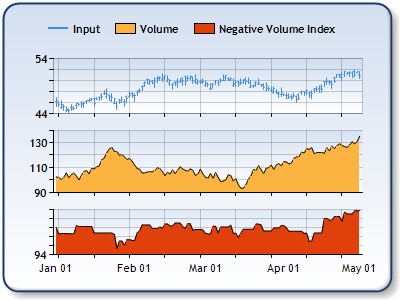Overview

The Negative Volume Index should be used in concert with the Positive Volume index. The Negative Volume Index only changes if the volume decreases from the previous day.
 Note Note |
|---|
| We recommend that you read Using Financial Formulas before proceeding any further. Using Financial Formulas provides a detailed explanation on how to use formulas, and also explains the various options available to you when applying a formula. |
 |
|
Figure 1: The Negative Volume Index in the lower chart area, with it's Volume in the middle chart area. The Close price is plotted in the upper chart area. |
Applying a Negative Volume Index
All formulas are calculated using the FormulaFinancial method, which accepts the following arguments: a formula name; input value(s); output value(s), and parameter(s) that are specific to the type of formula being applied.
Before applying the FormulaFinancial method, make sure that all data points have their XValue property set, and that their series' XValueIndexed property is set to false.
The following table indicates what sort of FormulaFinancial method arguments to use when calculating a Negative Volume Index, and also supplies a description of what these parameters mean:
| Parameter |
Value/Description |
Example |
| Formula Name: |
NegativeVolumeIndex
|
FormulaFinancial(FinancialFormula.NegativeVolumeIndex,"100","Series1:Y4,Series2:Y", Series3:Y") |
| Input Values: | Value #1: Value which represents the Close price. By default this is the fourth Y value in the stock chart. Value #2: Value which represents Volume. |
FormulaFinancial(FinancialFormula.NegativeVolumeIndex,"100"," Series1:Y4,Series2:Y", Series3:Y") |
| Output Value: (optional) |
Negative Volume Index. If not specified output is stored in the first input value. |
FormulaFinancial(FinancialFormula.NegativeVolumeIndex,"100","Series1:Y4,Series2:Y", Series3:Y") |
|
Parameter: |
Start Value, is initial value for Negative Volume index (Double value). |
FormulaFinancial(FinancialFormula.NegativeVolumeIndex,"100","Series1:Y4,Series2:Y", Series3:Y") |
A line chart is a good choice when displaying a Negative Volume Index series.
Financial Interpretation:
When a Negative Volume index is above its moving average there is higher probability for a bull market. The probability for a bull market is much lower when the negative flow index is below it's moving average.
Calculation: If Today's volume is lower than yesterday's volume.
NVI(today) = (Close(today) - Close(yesterday) ) / Close(yesterday) * NVI(yesterday) + NVI(yesterday)
If Today's volume is greater than yesterday's volume.
NVI(today) = NVI(yesterday)
Example
This example demonstrates how to calculate the Negative Volume Index.
| Visual Basic |  Copy Code Copy Code |
|---|---|
| |
| C# |  Copy Code Copy Code |
|---|---|
| |
Financial Formulas
Formulas Overview
Using Financial Formulas





